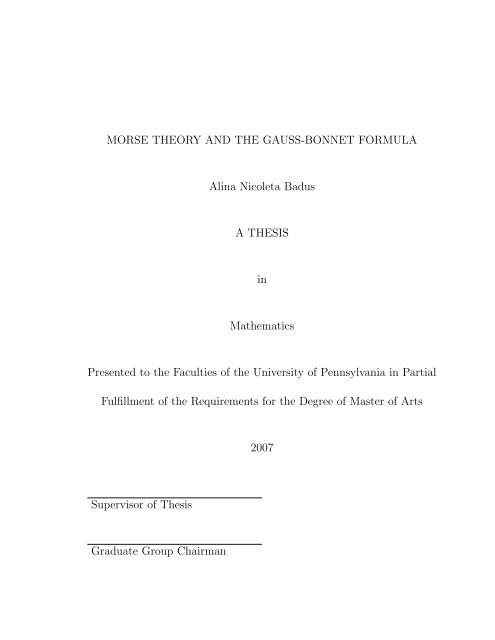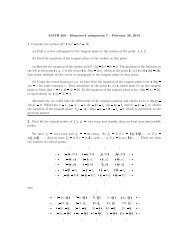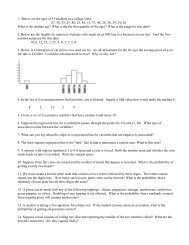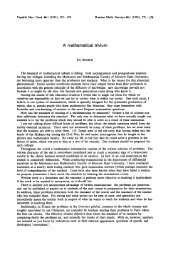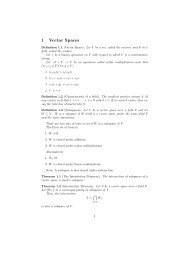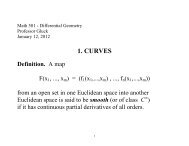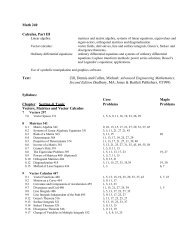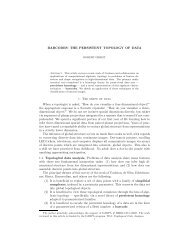MORSE THEORY AND THE GAUSS-BONNET FORMULA Alina ...
MORSE THEORY AND THE GAUSS-BONNET FORMULA Alina ...
MORSE THEORY AND THE GAUSS-BONNET FORMULA Alina ...
Create successful ePaper yourself
Turn your PDF publications into a flip-book with our unique Google optimized e-Paper software.
<strong>MORSE</strong> <strong><strong>THE</strong>ORY</strong> <strong>AND</strong> <strong>THE</strong> <strong>GAUSS</strong>-<strong>BONNET</strong> <strong>FORMULA</strong><br />
<strong>Alina</strong> Nicoleta Badus<br />
A <strong>THE</strong>SIS<br />
in<br />
Mathematics<br />
Presented to the Faculties of the University of Pennsylvania in Partial<br />
Fulfillment of the Requirements for the Degree of Master of Arts<br />
Supervisor of Thesis<br />
Graduate Group Chairman<br />
2007
A special thanks to Professor Christopher Croke for all his help.<br />
ii
1 Introduction<br />
The simplest version of the Gauss-Bonnet theorem was probably known in the time<br />
of Thales and states that the sum of the interior angles of a triangle in the Euclidean<br />
plane equals π. The nineteenth century version applies to a compact surface S with<br />
smooth boundary ∂S and Euler characteristic χ(S):<br />
�<br />
S<br />
�<br />
KdA +<br />
∂S<br />
κg(s)ds = 2πχ(S)<br />
where K is the Gauss curvature of S and κg is the geodesic curvature of the boundary.<br />
In this paper we survey generalizations of the Gauss-Bonnet formula to higher-<br />
dimensional manifolds, with or without boundary. Section 2 describes the work of<br />
Hopf, the contribution of Allendoerfer and Fenchel, as well as the intrinsic proof by<br />
Chern. In section 3 we present tools from Morse theory and the theory of isometric<br />
immersions, which are used in section 4 to give an extrinsic proof of the Gauss-Bonnet<br />
formula for closed manifolds embedded in Euclidean space. Section 5 generalizes these<br />
ideas to manifolds with boundary, manifolds embedded in Euclidean spheres and non-<br />
compact manifolds. While many of the results have already appeared in [10] and [5],<br />
this is to our knowledge the first study of the Gauss-Bonnet formula for submanifolds<br />
of the sphere.<br />
1
2 Gauss-Bonnet formula in higher dimensions<br />
The Euler characteristic generalizes easily to manifolds M of any dimension n:<br />
n�<br />
χ(M) = bk, where bk = dim Hk (M) is the k-th Betti number of M with coefficients<br />
k=0<br />
in Z, Q or Zp. An alternative definition begins with a smooth vector field V on M. A<br />
point x ∈ M is a singular point of V if V (x) = 0. A singular point x is called isolated<br />
if it has a neighborhood U such that U \ {x} contains no singular points of V .<br />
The index of an isolated singular point of V is defined as follows. For ɛ > 0<br />
small enough, the set Sɛ(x) = {y ∈ M : d(x, y) = ɛ} is diffeomorphic to S n−1 and it<br />
encloses a ball Bɛ(x) = {y ∈ M : d(x, y) ≤ ɛ} that contains no singular points of V<br />
except for x. For every y ∈ Sɛ(x) we can connect x and y via a unique minimizing<br />
geodesic γ (if ɛ is small enough) and parallel translate V (y) along γ to obtain a vector<br />
Vy ∈ TxM. As Vy points to a direction in the unit sphere S n−1 ⊂ TxM, we obtain a<br />
map φ : Sɛ(x) → S n−1 . If we choose compatible orientations on the two spheres (for<br />
example, via the exponential map expx) then the degree of φ is well-defined and we<br />
say that the index of V at x is exactly the index of the map φ.<br />
For a compact manifold M we have a theorem of Poincaré:<br />
Theorem 2.1. The sum of the indices of a smooth vector field V with isolated sin-<br />
gularities on M is equal to the Euler characteristic of M.<br />
However, it is not entirely obvious how to generalize the integrands in the Gauss-<br />
Bonnet formula. One approach is to use the fact that the Gaussian curvature of a<br />
surface is the product of its principal curvatures. If M is a hypersurface in Euclidean<br />
2
space, we can define principal curvatures in a canonical fashion, up to a choice of<br />
normal vector (see section 3.2); the Gaussian curvature of M is then defined to be<br />
the product of the principal curvatures. For an even-dimensional hypersurface, this<br />
Gaussian curvature does not depend on the choice of normal vector, and in 1925 Hopf<br />
proved the following:<br />
Theorem 2.2. Let M 2n ⊂ R 2n+1 be a compact embedded hypersurface. Then<br />
(2π) n �<br />
χ(M) = 1 · 3 · · · (2n − 1) κ1 · · · κ2ndVM<br />
M<br />
where the κi’s are the principal curvatures of M and dVM is the Riemannian volume<br />
form on M.<br />
For an odd-dimensional hypersurface M 2n+1 , the sign of the expression κ1, ..., κ2n+1<br />
does depend on the choice of a normal vector; more specifically, it changes sign if the<br />
normal vector changes sign. In any case, χ(M) = 0 for odd-dimensional compact<br />
manifolds, so we expect that any integral in a generalized Gauss-Bonnet formula<br />
should be zero. The interesting case is the even-dimensional one, so for the rest of<br />
this section we will assume that M has even dimension 2n.<br />
2.1 Allendoerfer and Fenchel’s tube proof<br />
In 1940 Allendoerfer [1] and Fenchel [7] succeeded in generalizing Hopf’s result to<br />
all compact even-dimensional submanifolds of Euclidean space, using techniques from<br />
Weyl’s theory of tubes. In general, if M is a submanifold of N we define the tube of<br />
radius r around M as<br />
3
T (M, r) = {x ∈ N : there is a geodesic γ of length l(γ) ≤ r from x meeting M<br />
orthogonally}<br />
Weyl [11] showed that, for a submanifold M 2n of R N :<br />
Vol T (M, r) = (πr2 ) (N−2n)/2<br />
((N−2n)/2)!<br />
n�<br />
i=0<br />
k2i(M)r 2i<br />
(N − 2n + 2)(N − 2n + 4)...(N − 2n + 2i)<br />
where the k2i’s are integrals of certain rather complicated curvature functions. For<br />
�<br />
example, k0(M) = Vol M and k2(M) = τdV where τ is the scalar curvature of<br />
M. For our purposes, the most interesting coefficient is the top one, k2n(M). The<br />
connection between this coefficient and the Gauss-Bonnet theorem is provided by the<br />
Pfaffian of a certain matrix of curvature forms, as described below.<br />
M<br />
Let A be a 2n × 2n antisymmetric matrix, with respect to the standard basis<br />
x1, ..., x2n on R 2n . We can define a 2-form ω on R 2n by ω(X, Y ) = 〈AX, Y 〉 for<br />
any vectors X, Y . If dx1, ..., dx2n are the dual 1-forms for the standard basis, then<br />
we define the Pfaffian Pf(A) by ω n = Pf(A)dx1 ∧ ... ∧ dx2n. One can show that<br />
Pf(A) = 1<br />
2 n n!<br />
�<br />
σ∈S2n<br />
ɛσAσ1σ2...Aσ2n−1σ2n where S2n denotes the set of permutations on<br />
2n letters and ɛσ is 1 if σ is an even permutation, −1 otherwise. The Pfaffian also<br />
satisfies Pf(A) 2 = det(A) and Pf(CDC T ) = Pf(D) det(C) for any antisymmetric<br />
matrix D and arbitrary matrix C.<br />
In our case, let {Ei, ..., E2n} be a local orthonormal frame. Define curvature forms<br />
Ωij with respect to this frame as the 2-forms satisfying Ωij(X, Y ) = 〈R(X, Y )Ei, Ej〉<br />
for any vector fields X, Y , where R is the curvature tensor of M. Then the matrix<br />
4
of curvature forms Ω = (Ωij) is antisymmetric and we can define its Pfaffian as<br />
the 2n-form Pf(Ω) = 1<br />
2 n n!<br />
�<br />
σ∈S2n<br />
ɛσΩσ1σ2...Ωσ2n−1σ2n on M. One can show (see [8] for<br />
details) that Pf(Ω) does not depend on the choice of local orthonormal frame and<br />
�<br />
that k2n(M) = Pf(Ω).<br />
M<br />
If M 2n �<br />
is a hypersurface, then it can be proven that 1·3···(2n−1)<br />
�<br />
κ1···κ2ndVM<br />
M<br />
equals Pf(Ω), so theorem 2.2 can be expressed as: (2π) nχ(M) = k2n(M).<br />
M<br />
Allendoerfer and Fenchel’s contribution is to relate the Euler characteristics and<br />
top k coefficients of a manifold and the tube around it. Recall that M 2n was a sub-<br />
manifold of R N . Without loss of generality we may replace N by 2N +1 and consider<br />
the tube T (M, r) around M. Its boundary Mr = ∂T (M, r) is an even-dimensional<br />
hypersurface if r is small enough, so (2π) N χ(Mr) = k2N(Mr). On the other hand,<br />
Mr is a bundle over M with fiber S 2N−2n , so χ(Mr) = χ(M)χ(S 2N−2n ) = 2χ(M).<br />
Finally, they were able to prove that k2N(Mr) = 2(2π) N−n k2n(M). Combining these<br />
results, we obtain:<br />
Theorem 2.3. Generalized Gauss-Bonnet theorem<br />
(2π) n �<br />
χ(M) = k2n(M) =<br />
Proof. k2n(M) = k2N (Mr)<br />
2(2π) N−n = (2π)N χ(Mr)<br />
2(2π) N−n<br />
M<br />
Pf(Ω)<br />
= (2π)N ·2χ(M)<br />
2(2π) N−n = (2π) n χ(M) �<br />
At the time it was not known whether every compact manifold can be embedded<br />
in Euclidean space; an answer to this question was only given by Nash in the 1950’s.<br />
However, the result is independent of the actual embedding of M and in 1944 Chern<br />
5
gave an intrinsic proof of the formula. His paper [2] was so well received that<br />
Allendoerfer and Fenchel’s formula is now known as the Gauss-Bonnet-Chern formula.<br />
2.2 Chern’s intrinsic proof: a sketch<br />
As above, let M 2n be a compact, even-dimensional manifold and consider its unit<br />
tangent bundle UM. Let π be the projection map UM → M. Chern proved that<br />
the pullback of the 2n-degree Euler form ω = 1<br />
(2π) n/2 Pf(Ω) to UM is an exact form:<br />
π ∗ (ω) = dΦ for some (2n − 1)-form Φ on UM.<br />
If V is a smooth vector field on M with isolated non-degenerate zeroes then the<br />
vector field X = V<br />
�V �<br />
has only isolated singularities; let U be the set of singularities<br />
of X on M. We can view X as a section X : M \ U → UM. Chern proved that the<br />
boundary of the image X(M \ U) is an (2n − 1)-dimensional cycle of UM. Then, by<br />
Stokes’ theorem:<br />
� �<br />
ω = X ∗ �<br />
(dΦ) =<br />
M<br />
M\U<br />
X(M\U)<br />
�<br />
dΦ =<br />
∂X(M\U)<br />
With some work one can show that the last integral is exactly the sum of the<br />
indices of the vector field X. By theorem 2.1, this is equal to χ(M).<br />
3 Tools: Morse Theory and Integral Geometry<br />
For the remainder of this paper we drop the requirement that M has even dimension.<br />
Φ<br />
6
3.1 Morse theory review<br />
Let f : M n → R be a smooth function on a closed manifold M. We say that a<br />
point p ∈ M is a critical point for f if the induced map f∗ : TpM → Tf(p)R is zero.<br />
For such a critical point we define the Hessian of f at p as a symmetric bilinear<br />
functional f∗∗ on TpM acting on vectors as follows: if v, w ∈ TpM then consider<br />
their extensions V, W to vector fields tangent to M in a neighborhood of p and let<br />
f∗∗(v, w) = Vp(W (f)) (where Vp = v). One can check that f∗∗ is symmetric and<br />
independent of the extensions V, W .<br />
The index of a bilinear functional A on a vector space V is defined to be the<br />
maximal dimension of a subspace of V on which A is negative definite; the nullity of<br />
A is the dimension of its nullspace, the space of all vectors v such that A(v, w) = 0<br />
for all w ∈ V . We define the index of f at p to be the index of the bilinear map f∗∗<br />
at p. We say that p is a degenerate critical point if the nullity of f∗∗ at p is zero and<br />
a non-degenerate critical point otherwise.<br />
If (x1, ..., xn) is a local coordinate system around p, then p is critical if and only<br />
if ∂f<br />
∂f<br />
(p) = ... = ∂x1 ∂xn (p) = 0. If v = � ai ∂<br />
∂xi |p and w = � bj ∂<br />
∂xj |p are vectors in<br />
TpM(for some constants ai, bj) then f∗∗(v, w) = �<br />
i,j<br />
aibj<br />
7<br />
∂2f (p). Therefore the<br />
∂xi∂xj<br />
matrix associated to f∗∗ with respect to the basis ∂<br />
∂x1 |p, ..., ∂<br />
∂xn |p is ( ∂2 f<br />
∂xi∂xj<br />
(p)) and<br />
one can check that p is a nondegenerate critical point of f if and only if this matrix<br />
is nonsingular. We can also prove that the index of f∗∗ is the number of negative<br />
eigenvalues of this matrix, a number which does not depend on the coordinates chosen.
Definition 3.1. f is a Morse function if it has no degenerate critical points on M.<br />
Morse functions are very useful for understanding the geometry and topology of<br />
compact manifolds and the standard reference for their properties is [9]. Here are<br />
some of the statements most relevant for our study:<br />
Theorem 3.2. Morse Lemma. [9] Let p be a nondegenerate critical point of f and<br />
let k be the index of f at p. Then there is a local coordinate system (x1, ..., xn) in a<br />
neighborhood U of p with xi(p) = 0 for all i such that in the entire neighborhood U<br />
we have f = f(p) − x 2 1 − ... − x 2 k + x2 k+1 + ... + x2 n.<br />
Theorem 3.3. [9] If f is a Morse function on M and every M a = f −1 (−∞, a] is<br />
compact, then M has the homotopy type of a CW-complex, with one cell of dimension<br />
k for each critical point of index k.<br />
Theorem 3.4. (Weak) Morse Inequalities. [9] If bk is the k-th Betti number of<br />
M and Ck denotes the set of critical points of index k of a Morse function on M then<br />
bk ≤ #Ck for any k and �<br />
(−1) k #Ck = �<br />
(−1) k bk = χ(M).<br />
k<br />
k<br />
Morse theory also works on a manifold with boundary, if we count nondegenerate<br />
critical points carefully. If M is a compact manifold with boundary ∂M and f :<br />
M → R is a smooth function, consider f|M\∂M and f|∂M separately. A critical point<br />
of f|M\∂M is a point p ∈ M \ ∂M where the induced map from Tp(M \ ∂M) to Tf(p)R<br />
is zero, and degeneracy is defined in the same fashion as before. Since ∂M is an<br />
(n − 1)-manifold, we can simply consider f|∂M : ∂M → R; a critical point is again<br />
a point p ∈ ∂M where the map (f|∂M)∗ : Tp∂M → Tf(p)R is zero. Such a critical<br />
8
point is degenerate if the Hessian (f|∂M)∗∗ has nullity > 0. The function f is called a<br />
Morse function if both the maps f|M\∂M and f|∂M are Morse functions in the sense<br />
of definition 3.1 above.<br />
At every point x ∈ ∂M we can define a canonical unit vector νout pointing outward<br />
with respect to M. Let f be a Morse function on M such that ∇f is never orthogonal<br />
to νout. Consider the sets<br />
Ck = {p ∈ M \ ∂M : the index of f|M\∂M at p is k}<br />
Dk = {p ∈ ∂M : 〈∇f, νout〉 < 0 and the index of f|∂M at p is k}.<br />
n�<br />
Then (−1) k �n−1<br />
#Ck + (−1) k #Dk = χ(M).<br />
k=0<br />
k=0<br />
Example. Let M be a punctured torus T 2 − {pt}; it is not difficult to compute<br />
χ(M) = −1. Consider two embeddings of M into R 3 and in both cases let f : M → R<br />
be the height function corresponding to the z coordinate of the embedding.<br />
In the left-most embedding, the entire boundary consists of critical points, all of<br />
which are degenerate; therefore, the height function is not a Morse function for this<br />
embedding. In the second embedding, there are 2 critical points on the boundary and<br />
4 critical points in the interior of M, all of which are nondegenerate. However, the<br />
point b on the boundary is not counted, as 〈∇f, νout〉 > 0 at b.<br />
9
index(p) = 2, index(q) = index(r) = index(a) = 1, index(s) = 0, and we obtain<br />
χ(M) = (−1) 0 · 1 + (−1) 1 · 3 + (−1) 2 · 1 = −1 as expected.<br />
Example. Consider the annulus M ⊂ R 2 and the height function h representing<br />
the y-coordinate. There are four critical points, all on the boundary, but only two of<br />
them are used for computing χ(M) = (−1) 0 · 1 + (−1) 2 · 1 = 0.<br />
3.2 Isometric immersions and the Gauss map<br />
Let M n be a submanifold of R N . The unit normal bundle of M is a bundle with fiber<br />
S N−n−1 and total space of dimension N − 1 defined as:<br />
ν 1 M = {(x, u) : x ∈ M, u ∈ TxR N , u ⊥ TxM and �u� = 1}<br />
For any (x, u) ∈ ν 1 M, the tangent space T(x,u)ν 1 M splits into a horizontal subspace<br />
and a vertical subspace: T(x,u)ν 1 M = Hor T(x,u)ν 1 M ⊕Vert T(x,u)ν 1 M. In the canonical<br />
metric on ν 1 M the horizontal and vertical subspaces are orthogonal to each other.<br />
This splitting gives a canonical volume form dV ν 1 M on ν 1 M which locally coincides<br />
with dVM ∧ dV S N−n−1.<br />
10
Since we are working with an embedded manifold, we will also need to consider<br />
the ”shape” of the embedding, given by the second fundamental form. If f : M → N<br />
is an isometric embedding, we define the second fundamental form (or shape operator<br />
in [6]) to be a map that associates to every normal vector u ⊥ TxM the unique<br />
self-adjoint operator Au : TxM → TxM satisfying 〈Au(v), w〉 = 〈∇V W, u〉. Here V<br />
and W are extensions of v and w, respectively, to vector fields tangent to M in a<br />
small neighborhood of x, and ∇ is the covariant derivative in the ambient manifold<br />
N. One can show that this definition does not depend on the extensions chosen and<br />
that Au(v) = −(∇vU) T where U is a vector field normal to M extending u on a small<br />
neighborhood and T denotes the tangential component of the derivative. Again, this<br />
equality does not depend on the extension U.<br />
As a self-adjoint operator, Au has real eigenvalues κ1, ..., κn called the principal<br />
curvatures of the embedded submanifold M in the direction of u. The determinant<br />
det Au = κ1 · ... · κn is a generalization of the Gaussian curvature of a surface. In the<br />
case of a hypersurface, det Au is called the Gauss-Kronecker curvature.<br />
Recall that M is a submanifold of R N . For some x ∈ M we can interpret TxM as<br />
an n-subspace of R N , and view ν 1 xM as the set of all unit vectors in R N orthogonal<br />
to TxM. Then we can define the Gauss map G : ν 1 M → S N−1 ⊂ R N by G(x, u) = u.<br />
It is known (see [3] or [10]) that G ∗ (dVS)G(x,u) = |det Au|(dV ν 1 M)u for all u ∈ ν 1 M.<br />
In particular, u ∈ ν 1 M is a regular point for G if and only if Au is invertible.<br />
11
4 An Extrinsic Proof<br />
4.1 A proof of the Gauss-Bonnet theorem<br />
Let M n be a compact manifold embedded isometrically in R N for some N > n with<br />
unit normal bundle ν 1 M.<br />
Theorem 4.1. Extrinsic Gauss-Bonnet Theorem<br />
�<br />
ν 1 M<br />
�<br />
ν 1 M<br />
det AudV ν 1 M(u) = χ(M) Vol(S N−1 )<br />
Notice that if n is odd then det A−u = − det Au. By Fubini’s theorem,<br />
� �<br />
�<br />
det AudVν1M(u) = det AudVν1 pMdp = 0dp = 0, and χ(M) = 0.<br />
M<br />
ν 1 pM<br />
The proof is a beautiful application of Morse theory and integral geometry and<br />
we will describe it in the remainder of this section.<br />
Definition 4.2. For a unit vector v ∈ S N−1 , define the height function hv : M → R<br />
by hv(p) = 〈p, v〉. In this context, p represents a point in M as well as the vector<br />
connecting the origin of R N with that point.<br />
Proposition 4.3. S0 = {v ∈ S N−1 : hv is a Morse function } has full measure in<br />
S N−1 .<br />
From the definition of height functions we can deduce that p ∈ M is a critical point<br />
for the height function hv if and only if v is orthogonal to TpM. This is equivalent<br />
to v being parallel to some normal vector u ∈ ν 1 M based at p. Moreover, there is a<br />
close connection between height functions and the second fundamental form:<br />
M<br />
12
Lemma 4.4. If u ∈ ν 1 M is based at p ∈ M then the Hessian of hu at p is equal to<br />
the second fundamental form Au at p.<br />
Proof. Let f : R n → R N be a local parametrization of M in a neighborhood U<br />
around p, with f(0) = p. Then X1 = ∂<br />
∂x1 , ..., Xn = ∂<br />
∂xn form a basis for TqM, for all<br />
q ∈ U. As both the Hessian and the second fundamental form are linear operators, it<br />
suffices to show that hess hu(p)(Xk, Xl) = 〈Au(Xk), Xl〉 for all k, l. This is equivalent<br />
to proving that ∂ 2 hu<br />
∂xk∂xj = 〈∇Xk Xj, u〉 for all k, l.<br />
Write f(x1, ..., xn) = (f1(x1, ..., xn), ..., fN(x1, ..., xn)) and let e1, ..., eN be the stan-<br />
dard basis of R N . Without loss of generality we may assume that u = eN and therefore<br />
hu(f(x1, ..., xn)) = fN(x1, ..., xn). Also, Xk = � ∂fi<br />
ei and Xl =<br />
∂xk<br />
� ∂fj<br />
ej. We can<br />
∂xl<br />
now compute:<br />
∇XkXl = �<br />
∇Xk<br />
j<br />
(∂fj ej) =<br />
∂xl<br />
� ∂<br />
j<br />
2fj ej +<br />
∂xl∂xk<br />
� ∂fi<br />
∇ei<br />
∂xk i,j<br />
ej = � ∂<br />
j<br />
2fj ej<br />
∂xl∂xk<br />
Finally, 〈∇XkXl, u〉 = 〈∇XkXl, eN〉 = ∂2fN ∂xl∂xk<br />
as desired. �<br />
Corollary 4.5. p is a nondegenerate critical point for hu iff Au is invertible.<br />
Proof of proposition 4.3. Corollary 4.5 implies that p is a nondegenerate<br />
critical point for hv if and only if v is a regular value of the Gauss map G. But G is<br />
a smooth map, so by Sard’s theorem the set of its critical values has measure zero in<br />
S N−1 . As S0 is exactly the set of regular values of G, we can conclude that S0 has<br />
full measure in S N−1 . �<br />
Lemma 4.6. For any v ∈ S0, G −1 (v) is a finite set. Moreover, there exists a neigh-<br />
borhood U of v such that G| G −1 (U) : G −1 (U) → U is a finite covering map.<br />
i<br />
j<br />
13
Proof. Suppose G −1 (v) was infinite. Since ν 1 M is compact, we can extract<br />
a convergent sequence {ai} ⊂ G −1 (v) converging to some element a ∈ ν 1 M. By<br />
continuity we must have G(a) = v as well, so a is a regular point of G. Therefore, for<br />
any neighborhood V1 of a there exists some element ai that also maps to v. However,<br />
if a is a regular point of G then there exists a neighborhood V2 of a such that G|V2 is<br />
a homeomorphism; this contradicts the existence of the sequence ai.<br />
As v is regular and has finitely many preimages, we can conclude that v has a<br />
neighborhood U such that G−1 � �<br />
(U) = U1 ... Uk is a finite disjoint union of open<br />
sets Ui, each of which is homeomorphic to U. �<br />
Corollary 4.7. For any function f : ν 1 M → R we have<br />
�<br />
ν 1 M<br />
�<br />
f(u)|det dG|dVν1M(u) =<br />
�<br />
SN−1 u∈G−1 (v)<br />
f(u)dV S N−1(v)<br />
Technically, the corollary should only allow us to compute integrals over S0. How-<br />
ever, S0 has full measure in S N so we can replace integrals over S0 with integrals over<br />
S N .<br />
Proof of theorem 4.1<br />
Define Ck(v) = {(v, p) ∈ S0 × M : p is a critical point of index k for hv} for every<br />
n�<br />
v ∈ S0. Then (−1) k #Ck(v) = χ(M) by the Morse inequalities.<br />
k=0<br />
14
Apply the previous corollary to the function f(u) = (−1) index Au :<br />
�<br />
ν 1 M<br />
�<br />
det AudVν1M(u) =<br />
�<br />
=<br />
�<br />
=<br />
ν 1 M<br />
(−1) index Au |det dG|dV ν 1 M(u)<br />
�<br />
SN−1 u∈G−1 (v)<br />
SN−1 k=0<br />
4.2 The Chern-Lashof results<br />
(−1) index Au dV S N−1(v)<br />
n�<br />
(−1) k #Ck(v)dVSN−1(v) = χ(M) Vol(S N−1 )<br />
In [3] and [4], Chern and Lashof study the absolute total curvature of a mani-<br />
fold M immersed in R N . The total absolute curvature is defined as AT C(M) =<br />
�<br />
M<br />
�<br />
ν 1 p M|det dGu|dudp. They proved that:<br />
Theorem 4.8. [3], [4] Let M n be a compact manifold immersed in RN . Then:<br />
n�<br />
i) AT C(M) ≥ bk · Vol(S N−1) ; in particular, AT C(M) ≥ 2 Vol(SN−1 );<br />
k=0<br />
ii) If AT C(M) < 3 Vol(SN−1 ) then M is homeomorphic to Sn .<br />
iii) If AT C(M) = 2 Vol(S N−1 ) then M n is embedded as a convex hypersurface in<br />
an (n + 1)-dimensional linear subspace of R N .<br />
The purpose of this subsection is to prove the first two parts of this theorem using<br />
Morse theory methods for embedded manifolds. Chern and Lashof also use Morse<br />
theory and the Gauss map, but they use differential forms to show that almost all<br />
the height functions are Morse functions.<br />
15<br />
�
Apply corollary 4.7 for the function f : ν 1 M → R, f(u) = 1; then:<br />
�<br />
AT C(M) =<br />
�<br />
=<br />
�<br />
=<br />
M<br />
�<br />
ν 1 pM<br />
SN−1 u∈G−1 (v)<br />
SN−1 k=0<br />
�<br />
|det dGu|dudp =<br />
�<br />
1 · dV S N−1(v)<br />
ν 1 M<br />
n�<br />
#Ck(v)dVSN−1(v) ≥<br />
|det dGu|dV ν 1 M<br />
n�<br />
bk · Vol(S N−1 )<br />
But b0 ≥ 1 for any manifold and bn = 1 if M is compact. Therefore,<br />
desired.<br />
k=0<br />
16<br />
n�<br />
bk ≥ 2 as<br />
If AT C(M) < 3 Vol(S N−1 ) then there exists a set A ⊂ S0 with positive measure<br />
such that for any v ∈ A the height function hv has less than 3 critical points on M.<br />
But if M is compact then every such hv has at least two critical points: an absolute<br />
minimum and an absolute maximum. We can conclude that all height functions hv<br />
with v ∈ A have exactly two critical points. By a theorem of Reeb’s (see [9]), if M<br />
is a compact manifold and f is a differential function on M with only two critical<br />
points, both of which are non-degenerate, then M is homeomorphic to a sphere. This<br />
completes the proof of (ii).<br />
The proof of part (iii) is more complicated. If AT C(M) = 2 Vol(S N−1 ) then hv<br />
must have exactly two critical points on M for almost all v ∈ S0. Chern and Lashof<br />
prove that if M is not contained in a linear subspace of dimension (n+1) then there is<br />
a neighborhood U ∈ S N−1 such that hv has at least three critical points for all v ∈ U.<br />
This is a contradiction and shows that M must be embedded in an (n + 1)-linear<br />
subspace. The proof that M is actually a convex hypersurface is also very interesting<br />
n=0
ut falls outside the scope of this discussion.<br />
5 Generalizations<br />
5.1 Manifolds with boundary<br />
Let M n be a compact submanifold of R N with boundary ∂M. Then ∂M is an<br />
embedded (n − 1)-submanifold of R N and at every point of ∂M we can define a<br />
unique outward pointing unit vector νout(x) tangent to M.<br />
The discussion in section 3.1 suggests that we should consider the bundle<br />
NM = ν 1 (M \ ∂M) � ν 1 +∂M where<br />
ν 1 (M \ ∂M) = {(x, v) : x ∈ M \ ∂M, v ∈ TxR N , v ⊥ TxM and �v� = 1} and<br />
ν 1 +∂M = {(x, v) : x ∈ ∂M, v ∈ TxR N , v ⊥ Tx∂M, �v� = 1 and 〈v, νout(x)〉 < 0}<br />
Notice that ν 1 (M \ ∂M) and ν 1 +∂M are bundles with the same total dimension<br />
N − 1. For ν 1 (M \ ∂M), the base space M \ ∂M has dimension n and the fiber has<br />
dimension N − n − 1; for ν 1 +∂M the base space ∂M has dimension n − 1, but the fiber<br />
has dimension N −n. The volume form on ν 1 (M \∂M) is locally a product dVM\∂M ∧<br />
dV S N−n−1 and the volume form on ν 1 +∂M is locally the product dV∂M ∧dV H N−n, where<br />
H N−n denotes the round unit hemisphere of dimension N − n.<br />
We can still define a smooth Gauss map G : NM → S N−1 by G(x, u) = u as<br />
a map between manifolds of the same dimension N − 1. As in section 3, one can<br />
prove that G ∗ (dVS)G(u) = |det Au|(dVNM)u for all u ∈ NM. In this formula, Au is<br />
17
the second fundamental form of M \ ∂M if u is based at some x ∈ M \ ∂M or the<br />
second fundamental form of ∂M if u is based on the boundary.<br />
Theorem 5.1. Gauss-Bonnet for manifolds with boundary<br />
�<br />
�<br />
det AudVν1M\∂M(u) +<br />
u∈ν 1 (M\∂M)<br />
u∈ν1 + ∂M<br />
det AudVν1 + ∂M(u) = χ(M) Vol(S N−1 )<br />
Proof. For every v ∈ S N−1 we consider the height function hv : M → R,<br />
hv(p) = 〈v, p〉. The result follows via essentially the same proof as for theorem 4.1.�<br />
Dillen and Kühnel offer an alternative proof of the theorem via the tube method,<br />
using the relation χ(NM) = (1 + (−1) N )χ(M); the details can be found in [5].<br />
5.2 Submanifolds of the sphere<br />
Let M n be a compact manifold without boundary isometrically embedded in a unit<br />
sphere S N . Applying Morse theory to distance functions on M will allow us to<br />
obtain yet another version of the Gauss-Bonnet formula, with the advantage that the<br />
integrand has a very interesting geometric interpretation.<br />
Consider the tube of radius r around M as defined in section 2.1. If r is small<br />
enough, the tube is an embedded submanifold of S N but for r = π the tube has self-<br />
intersections. However, its signed volume contains important topological information<br />
about M. More precisely, consider the normal disk bundle:<br />
ν π M = {(x, w) : x ∈ M, w ∈ TxS N , w ⊥ Tx and �w� ≤ π}<br />
18
and the map F : ν π M → S N , F (x, w) = expxw. Then the tube of radius π around M<br />
is T (M, π) = F (ν π M) and its signed volume is defined as<br />
�<br />
SVol T (M, π) =<br />
ν π M<br />
det dFudVν π M(u)<br />
where dV olν π M is the canonical volume form on ν π M.<br />
Example. Consider M = S 1 embedded in S 2 as a great circle. Then ν π S 1 is a<br />
cylinder S 1 × [−π, π] and the tube T (S 1 , π) = S 2 has volume 4π.<br />
However, the signed volume SVol T (S 1 , π) is zero, by the following theorem:<br />
Theorem 5.2. Gauss-Bonnet for submanifolds of the sphere.<br />
SVol T (M, π) = χ(M) Vol(S N )<br />
In order to prove this theorem, consider the distance function dp : M → R, x ↦→<br />
d(p, x) for some fixed p ∈ S N . Notice that x is a critical point of dp if and only if<br />
p = F (x, w) for some (x, w) ∈ ν π M.<br />
19
Lemma 5.3. S0 = {p ∈ S N : dp is a Morse function } has full measure in S N .<br />
Proof. From [9] we know that x ∈ M is a degenerate critical point of dp for<br />
some p = expxw if and only if p is a focal point of M. Therefore, dp is a Morse<br />
function whenever p is not a focal point of M. But focal points are critical values of<br />
the normal exponential map (see [6]), which is a smooth map; therefore, by Sard’s<br />
theorem, the set of focal points of M has measure zero in S N . �<br />
The Morse index theorem for distance functions (see [9]) states that the index of<br />
x ∈ M as a nondegenerate critical point of dp is exactly the number of focal points of<br />
M with base x situated on the segment from x to p, counted with multiplicities. As<br />
focal points are critical points of F , we can conclude that for every point q = F (x, v)<br />
on the segment from x to p the index of dF(x,v) equals the number of focal points<br />
between q and x. The inverse image of the set of focal points thus divides ν π M into<br />
regions with indices that increase as we move further from M.<br />
In the following proof we essentially compute the volume of all these regions, with<br />
the corresponding indices. It might be possible to study the regions individually, as<br />
they contain information about the number of critical points of distance functions<br />
and, implicitly, about the topology of M.<br />
Proof of theorem 5.2. For any p ∈ S0, let Ck(p) be the set of critical points of<br />
20<br />
�
dp of index k. By theorem 3.2,<br />
�<br />
ν π M<br />
n�<br />
(−1) k #Ck(v) = χ(M). Then:<br />
k=0<br />
det dFudVνπ �<br />
M(u) =<br />
�<br />
=<br />
�<br />
=<br />
ν π M<br />
(−1) index dFu |det dFu|dVν π M(u)<br />
�<br />
S0 u∈F −1 (p)<br />
S0 k=0<br />
(−1) index dFu dV S N (p)<br />
n�<br />
(−1) k #Ck(p)dVSN (p) = χ(M) Vol(S N )<br />
Remark. We can also compute explicitly the signed volume of a tube of radius<br />
r around M. The formula is<br />
�<br />
SVol T (M, r) =<br />
νM<br />
� r<br />
(sin t) N−n−1 (cos t + λ1 sin t)...(cos t + λn sin t)dtdVνM<br />
0<br />
where νM is the entire normal bundle of M inside S N , dVνM is the canonical volume<br />
form on νM and λ1, ..., λn are the eigenvalues of a second fundamental form. When<br />
n is odd the integral equals zero, as expected, since χ(M) = 0 for compact, odd-<br />
dimensional manifolds. However, attempts to compute the integral when M is even-<br />
dimensional have not been fruitful.<br />
Remark. We can also ask whether every compact manifold can be isometrically<br />
embedded in some S N , perhaps after a suitable scaling. Notice that a flat torus T n<br />
can be isometrically embedded (with scaling) in S 2n−1 via the map:<br />
(x1, ..., xn) ↦→ 1<br />
n (cos x1, sin x1, ..., cos xn, sin xn)<br />
By the Nash embedding theorem, any compact manifold can be isometrically<br />
embedded in Euclidean space, which can be embedded in a flat torus, perhaps after<br />
21<br />
�
some scaling. Therefore, any compact manifold can be isometrically embedded in an<br />
Euclidean sphere if we allow scaling.<br />
5.3 Noncompact complete manifolds<br />
Another possible generalization is to drop the assumption of compactness. Consider a<br />
complete noncompact surface S. We should require that χ(S) is finite, which implies<br />
that S must have finite topological type: it must have finite genus and only finitely<br />
many ends. Also, we should require that S has an absolutely integrable Gaussian<br />
�<br />
�<br />
curvature: |K|dA < ∞ in order to guarantee that the integral KdA converges<br />
S<br />
and is finite. In this context we have the following:<br />
�<br />
Theorem 5.4. Cohn-Vossen. 2πχ(S) −<br />
for any complete, noncompact surface.<br />
S<br />
�<br />
KdA ≥ 0. In particular,<br />
S<br />
S<br />
22<br />
KdA ≤ 2π<br />
The Gauss-Bonnet formula might still hold in some cases, or one can study the<br />
�<br />
curvature defect 2πχ(S) − KdA. For a recent study of this area and higher dimen-<br />
sional generalizations, see [5].<br />
S
References<br />
[1] C.B. Allendoerfer, The Euler number of a Riemann manifold, Amer. J. Math. 62 (1940), 243–<br />
248.<br />
[2] S.S. Chern, A simple intrinsic proof of the Gauss-Bonnet formula for closed Riemannian man-<br />
ifolds, Ann. of Math. (2) 45 (1944), 747–752. MR 0011027 (6,106a)<br />
[3] S.S. Chern and R.K. Lashof, On the total curvature of immersed manifolds, Amer. J. Math. 79<br />
(1957), 306–318.<br />
[4] , On the total curvature of immersed manifolds. II, Michigan Math. J. 5 (1958), 5–12.<br />
[5] F. Dillen and W. Kühnel, Total curvature of complete submanifolds of Euclidean space, Tohoku<br />
Math. J. (2) 57 (2005), no. 2, 171–200. MR 2137465 (2006e:53095)<br />
[6] M. P. do Carmo, Riemannian geometry, Mathematics: Theory & Applications, Birkhäuser<br />
Boston Inc., Boston, MA, 1992.<br />
[7] W. Fenchel, On total curvatures of Riemannian manifolds: I, J. London Math. Soc. 15 (1940),<br />
15–22.<br />
[8] A. Gray, Tubes, 2nd ed., Progress in Mathematics, vol. 221, Birkhäuser Verlag, Basel, 2004.<br />
[9] J. Milnor, Morse theory, Princeton University Press, Princeton, N.J., 1963.<br />
[10] D.V. Tausk, F. Mercuri, and P. Piccione, Notes on Morse theory, Publicações Matemáticas do<br />
IMPA. [IMPA Mathematical Publications], Instituto de Matemática Pura e Aplicada (IMPA),<br />
Rio de Janeiro, 2001.<br />
[11] H. Weyl, On the Volume of Tubes, Amer. J. Math. 61 (1939), no. 2, 461–472.<br />
23


